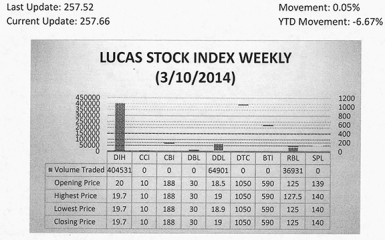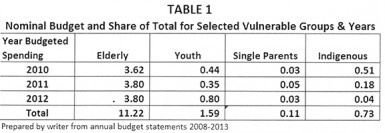Plight of vulnerable
This would be the final article on anticipations of the 2014 budget. When the series first started, the intention was to focus attention on the least exposed items of the budget proposal. They are the issues that do not attract as much attention as the activities in the productive sector of the economy. Yet, the budgetary spending to address the plight of vulnerable groups is as important as allocations to the productive sector of the economy. Crime, absenteeism, sickness and low literacy skills, all associated with poverty and members of vulnerable groups, impact the level of performance of the productive sector of the economy.
Classification
Despite their importance, the condition of the less fortunate or the vulnerable among us is a much neglected part of the budget debate. The budget generally identifies seven categories of persons which it regards as deserving attention under this label of ‘vulnerable.’ These include members of society who are children, the youth, elderly, single parents, homeless, indigenous communities and others. Others generally refer to persons who face economic hardships and are forced to depend on public assistance. The generic categorization could lead one to believe that all children are marginal to the economic fortunes of the country. So too could one think of young Guyanese, single parents and the elderly. The social classification of homeless is perhaps the only one that does not leave one to wonder as to what vulnerability and social marginalization persons are exposed.
Children, the youth, elderly, and single parents have been placed in the category of vulnerable for different reasons. The more generic social classifications such as children and youth lack differentiation until labels such as orphan or troubled are provided and lead one to a narrower but clearer focus of the item of expenditure. It is quite possible that there are overlapping causes for the vulnerability to which children are exposed. Among the troubled could be orphans and among the abused could be troubled children. An elaborate programme of activities and interventions are directed towards the vulnerable members of the society. Like the categorization of the vulnerable, the interventions consist of an array of activities. The interventions are varied and often spread across multiple policy lines and, as a result, across multiple agencies. For example, while the care and protection of vulnerable children might be the responsibility of the Social Services entity, education and health are part of the support services which these children receive. These latter items are the focus of the Ministries of Health and Education.

Assessment
Conducting an assessment of the benefits realized by the vulnerable groups is complicated by the fact that health and educational inputs, for example, are often counted under different budget headings. Their contribution therefore could easily be missed in tabulating the overall benefits derived from the social programmes designed to aid the vulnerable. These uncoordinated lines of resource transfer also complicate efforts at evaluating the financial input into the social investment and render difficult predictions about future spending in this area.
Economic condition
While the source of the problems facing the vulnerable might vary, a common cause is the economic situation in which many persons find themselves and the growing income gap in the country. This has often been cited as a contributing factor to many of the observed behaviours of domestic and child abuse, substance abuse and homelessness. Indeed, data in the budget presentations and income tax data have enabled one to see that at least 23 per cent of the persons employed enjoy less than eight per cent of the income earned in the Guyana economy over the last six years. Extending the finding to the larger economy, the many social problems that have managed to ensnare children and young Guyanese therefore might be larger than meets the eye. This reality raises questions of whether the current level of intervention is enough to first slow down the rate of occurrence and second prevent these troubles from reaching epidemic proportions.
The budget proposals have shared many insights about the level of resource allocation to the various members of the vulnerable category. Where the young Guyanese is concerned, the tendency has been to focus on sports and skills training so that these persons could be gainfully employed. However, the administration has been rather sporadic in sharing the amounts spent to do the several things that were proposed to support the many in the vulnerable category. This makes it difficult to assess with any degree of confidence the amount of income redistributed to this category of persons. What earlier budget submissions tell us is that the focus on the category of single parents is a relatively recent phenomenon. As with the youth, the interventions for this group seek to address the lack of skills among single parents. Even if many of them got jobs as a result of the skills training, some would need help in taking care of the children while they are off earning a living. This need has been recognized and support for daycare services forms part of the assistance given to single parents.
Direct transfers
It is against this background anticipations of the 2014 budget are discussed. It must be kept in mind too that unlike allocations for security, sanitation and water which are often delivered through third-party entities, some social protection actions represent direct transfers between the government and the beneficiaries. Examples of this type of spending are old-age pensions, public assistance and the grants for income-generating projects to indigenous groups and “Women-of-Worth”. One must acknowledge that there are gaps in the data presented in the annual budget as it pertains to several of the beneficiary groups and the level of funding for the various types of interventions. There is little time to scrub the data in order to make it useful to the type of discussion intended by this article. The paucity of data might in itself reflect the uncertainty by the administration of the level of support many of the recommended interventions should receive.
Lion’s share
Despite the limitations presented by the data, what is known with certainty is that four groups receive a substantial share of the budget allocations. These are the elderly, the indigenous communities, single parents and the youths. The data do not tell the entire story about the vulnerable members of society over the last six years, but it is possible to get a sense of how the money is distributed. As the table on below indicates, the lion’s share of the redistributed income or transfer payments made to the vulnerable goes to the elderly.
This group at times could receive between 70 to 80 per cent of the resources directed at vulnerable groups. This spending combines both capital and current expenditure.
In the particular years presented here, the elderly received 82 per cent of the identified allocations while the youths received 12 per cent. An estimated one per cent of the money was allocated to give single parents a second chance while five per cent was used to tackle poverty in the indigenous communities.
A matter of time
These groups represent important voting constituencies and it would be surprising if the budget allocations for 2014 did not reflect that reality. There is a likelihood therefore that budget allocations to the four groups could be increased in 2014. This outcome will be known in a matter of time.

The Lucas Stock Index (LSI) increased 0.05 percent in trading during the second week of March 2014. The stocks of three companies were traded with a total of 477,732 shares changing hands. There was one Climber and one Tumbler. The shares of Demerara Distillers Limited (DDL) rose 3 percent on the sale of 64,901 shares while those of Banks DIH (DIH) fell 1.50 percent on the sale of 404,531 shares. The shares of Republic Bank Limited (RBL) remained stable on the sale of 8,300 shares.





